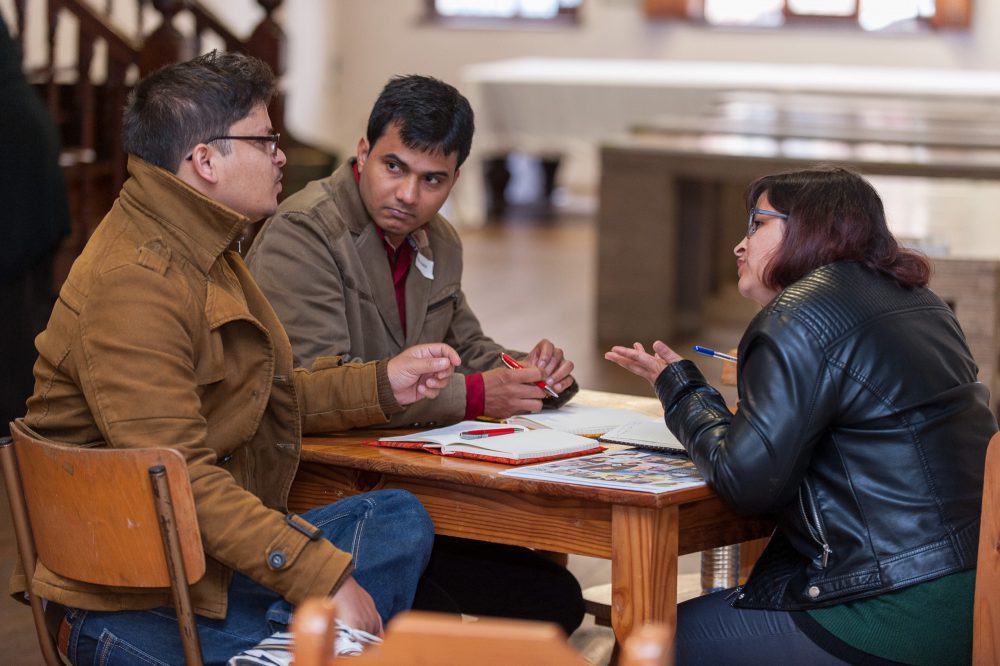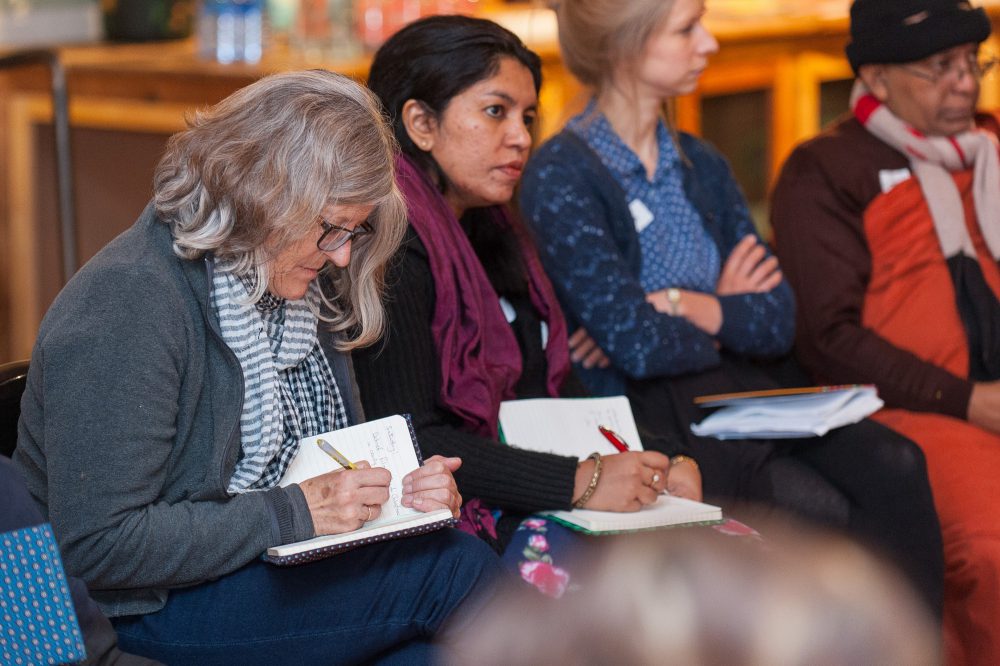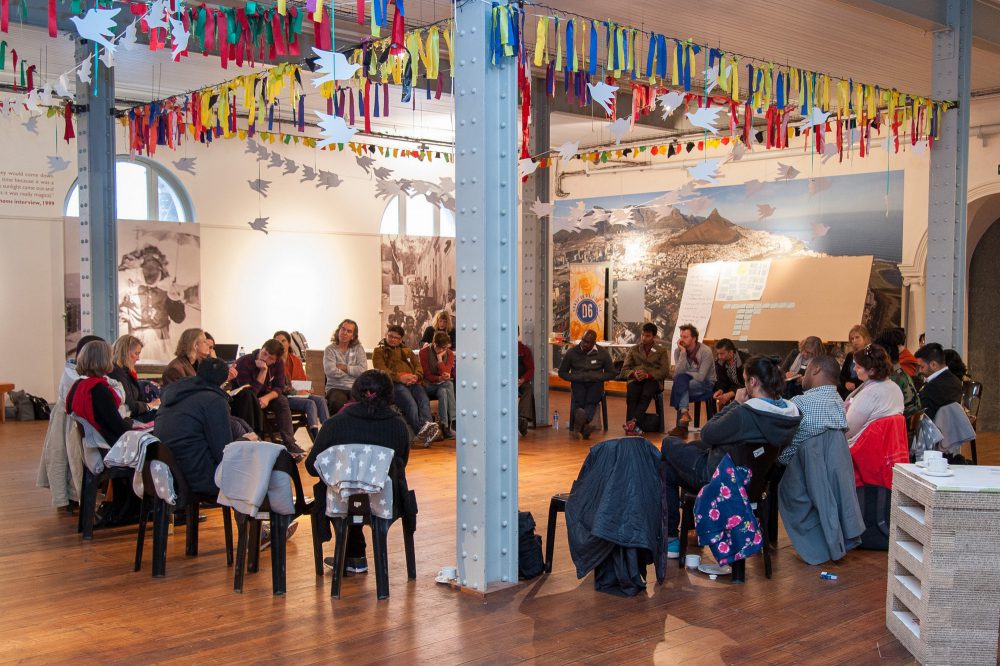The second round of the Mandela Dialogues on memory work was organised by the GIZ Global Leadership Academy (GIZ is the German international cooperation agency) and the Nelson Mandela Foundation. This dialogue was made up of two meetings, the first in Cape Town, South Africa (14-19 June) and the second in Batticaloa/Colombo, Sri Lanka (31 October – 5 November)
The participants included activists, researchers, artists, academics and representatives of institutions active in social memory work, a total of 29 participants from 9 countries: Argentina, Bosnia and Herzegovina, Croatia, South Africa, Colombia, Nepal, Rwanda, USA and Sri Lanka. Davorka Turk took part in the programme on behalf of CNA.
According to the words of the organiser, the topic of this year’s Mandela Dialogues covered two key challenges related to memory work, drawn from the first round of dialogues: creating safe spaces (“How do we create spaces that are safe enough to allow what is unutterable to be communicated, and where those who would prefer not to even see each other – former enemies, perpetrators and victims, winners and losers – can start listening to each other?”) across generational borders (“How to create the foundations for sustainable intergenerational action that will lead to social change and transformation?”).
The programme was held at the District Six Museum dedicated to the past of a forcibly resettled, and previously multicultural part of the city, told through the stories of its past residents. The first meeting in Cape Town was intended to help the participants get to know each other better, with less time devoted to exchange of knowledge, experience, challenges and opportunities specific to the practice of the participants and their home contexts. A special part of the programme included visits to local organisations and initiatives:
- The District Six Museum is a space dedicated to introducing viewers to the policy of forcible resettlements during apartheid, resistance to apartheid and the current struggle surrounding memory and social justice. The alternative tour of the Museum that we were offered presented the stories of District Six and its various locations, the formation of the museum, resettlement stories and return issues;
- Clowns Without Borders implement their programme “Our Story Your Story” in Cape Town’s poorest communities. Through autobiographic storytelling, they connect older members of the community to the youth that have no direct experience of living under apartheid, thereby working to increase community cohesion and empower its members. They took us to Philippi, one of Cape Town townships, at the Senior Citizens Centre where the Clowns implement their activities. We were joined by young people from another, equally large and impoverished township, Khayelitsha.
- Thanks to the Institute for Justice and Reconciliation, participants in the Mandela Dialogues took part in a dialogue between members of the Delft local community and the neighbouring Blikkiesdorpa on contentious issues between these two city districts.
- Thanks to the organisation of the Human Rights Media Centre we were able to participate in a dialogue between former enemies – members of the armed wing of the African National Congress (Umkhonto we Sizwve or MK) and former conscripts of the South African Defence Forces (SADF). We heard about their formative years during the 1970s and 1980s, about what influenced their life choices (during our stay in Cape Town, the 40th anniversary of the uprising in Soweto was marked) and about what they think today.
Although, nominally, it was the intention of these meetings, we generally lacked opportunities to learn more about the specificities and complexities of the South African context, both in terms of issues concerning the achievements of transitional justice (featuring the Commission for Truth and Reconciliation) and the current context of daily life in South Africa.

Between the two dialogue meetings, the participants were invited to undertake educational journeys – to meet organisations from their own contexts in order to change or widen perspectives on issues relevant to the work of the participants.
Many of the participants found creative ways to fulfil this task, using the opportunity to meet with initiatives they had not communicated or cooperated with before, and to create new contacts and links. We learned more about this during our first day in Sri Lanka. The two days we spent in Colombo served as a brief evaluation of the process so far and preparations to continue the dialogue meeting in the east of the country, which together with the north was a war zone for almost 30 years. The lack of roads and the economic isolation of this area (mostly inhabited by Tamils and Muslims, as well as other minority ethnic groups) is just one consequence of the war, which ended in 2009. The consequences of the war are manifold – a large number of killed and missing, a considerable number of kidnapped (by military and paramilitary formations carrying out forcible conscriptions), a large number of forcibly displaced persons, as well as refugees, widows (many of whom are unable to access basic rights for themselves and their children, because the process of identifying the missing has not started yet, and there are indications that the authorities will seek to drag it out even further). In addition, this area was one of the most hard-hit by the 2004 tsunami.
Something of the local Sri Lankan context could be gleaned by learning about the work of local organisations and initiatives:
- The Butterfly Peace Garden was established as an oasis for children from this war ravaged area, during one of the ceasefires between the rebel and government forces. Children come to the garden from the neighbouring villages and over 9 months, in mixed ethnic groups, they participate in a mixture of art, theatre, creative play, care for the environment and counselling, all of which are meant to help them heal the psychological effects of war. Another part of this effort is the Monkey’s Tale Centre for Contemplative Art that we also visited.
- The Inter-religious Dialogue Centre aims to encourage dialogue and understanding between the three major religious communities in this area – the Islamic, Hindu and Christian community – with a primary focus on the interaction of members of these communities in everyday life. The participants also visited the Heritage Museum and the local madrassa (Islamic religious school), as well as a memorial in a mosque commemorating members of the community killed by the LTTE[1].
- The Swami Vipulananda Institute for Art Studies, which uses the performance practice of traditional Koothu plays, establishes relations with and between marginalised ethnic groups in the east, such as the Vedda people (indigenous), the Arunthathiyar community (originating from Andhra Pradesh, India), the Burghers (of Dutch and Portuguese origin) and the Kaffirs (descendants of African slaves brought to Sri Lanka by the Portuguese). Together with performers from these communities, the participants visited a Vedda village where they had the opportunity to observe this performance-dialogue practice.
- The Valkai group is an initiative and support group for women exposed to various forms of violence – such as forcible conscription of children by the LTTE, abuse by the military, intimidation, “disappearances”, torture, etc. The participants attended a meeting of the group that discussed the recent government decision to open a Missing Persons Office, seen mostly as a response to demands made by international donors, more than as real support to the families of the missing.
- meeting with former LTTE members, some of whom were recruited as children and who are now mostly members of the association of persons with disabilities. In conversation, we found out that they mostly face obstacles preventing them from accessing their rights, finding employment and other forms of social and state support for integration into society, and are under constant surveillance by the authorities.
Since we didn’t have time to get to know all the above initiatives (everyone had the opportunity to participate in two of the above 6 local visits) or the depth of the problems they were facing, the group started wondering about the ethical aspect of these visits. Namely, on a number of occasions, we heard from local organisations that we were just another group that had come “to observe and take notes”. Namely, conditions had been put in place in Sri Lanka for the implementation of transitional justice principles, but, as we were told, little account was taken of the specificities of the Sri Lankan context. We did not discuss these visits as part of the programme, because the organisers intended them to serve simply as practice examples that we may decide to transfer to our own societies.
The important issues that we did discuss pertained to the very nature of memory work – What is memory – personal or social constructed experience; is it possible to create a safe space for all stakeholders, for whom is the space safe?; to what extent can our practices lead to silencing and inciting new violence, as opposed to transforming the conflict; to what extent is memory work its own end (what about the accusations that memory work diverts attention from more direct, and socially more “urgent” problems?), and how much can it truly aid social transformation? What about when memory is a threat we dare not speak out about (because its protagonists are still alive and politically active, some even in positions of power)? How do our societies treat survivors? What is the impact of the transitional justice process on the society where it is implemented? How do we understand reconciliation and why is it, politically speaking, almost always tied to forgiveness? How do power relations and/or social positions impact our work? How do we encourage intergenerational memory work that would be inclusive and not didactic? How do we talk to the younger generation that is suffering the consequences of the conflict, but does not feel part of that context? What is it that we want to achieve through intergenerational memory work?
It was certainly a privilege to participate in these meetings, for the opportunity they provided to get to know the social contexts we were visiting, and to exchange experience with practitioners from our field but from different ends of the globe. Unfortunately, the programme did not foresee a schedule or methodology for a more constructive approach to these issues, so for most we only managed to scratch the surface, unable to determine our common starting points, if any, or values at the core of our work and practices we employ to find answers. That would have helped fulfil the main intention of the organisers: to enable participants to enrich existing or establish new programmes within their institutions and countries, and to set up mutual cooperation where possible.

International Conference on Arts in Reconciliation
Bandaranaike Memorial International Conference Hall
7-9 November 2016 Colombo, Sri Lanka
The international conference held from 7 to 9 November in Colombo was organised by the Office for National Unity and Reconciliation of the Sri Lankan Government, the Arts Council of Sri Lanka, the European Union, CARE International, GIZ – German International Cooperation Agency and FLICT (Facilitating Initiatives for Social Cohesion and Transformation – a programme of the German Federal Ministry for Economic Cooperation and Development (BMZ) implemented by GIZ).
The conference focused on three areas – Art of Dissent, Art of Connecting and Art of Witness – through presentations, panel discussions and exhibitions on the role of art in reconciliation. The conference programme is available here.
Over the course of three days, 77 participants from different parts of the world had an opportunity to hear about academic research and artistic and activist practices in this field. Apart from panel discussions on comparative approaches to reconciliation, links between art, culture and peacebuilding, examination of the role of new media, intergenerational dialogue and the role of art in transforming conflict, we also had the opportunity to learn about concrete museological, memorialisation and artistic practices aiming to contribute to the process of reconciliation (literature, music, performance arts), but also about their limitations.
For those participants of the Mandela Dialogues that also attended this conference, it was an opportunity to learn more about each other’s projects. At the conference, CNA presented its work on researching and publishing findings about sites of suffering and memory in BiH after the 1991-1995 war, titled “War of Memories”.
Memorial walks (Histories of struggle and protest and Histories of violence and capitalisation) included in the conference programme proved to be particularly important in understanding the contemporary context of Sri Lanka, from the colonial period to today’s capitalist exploitation. For the participants of the Mandela Dialogues who had just spent 6 days in the protected environment of the Batticaloa Resort, visiting the Bandaranaike Memorial Centre under heavy security measures and in the presence of armed forces, and participating in the memorial walks presented a necessary encounter with the reality of daily life in a country that, although it is going through its post-colonial and post-war period, has not moved far from either, and not necessarily through its own fault.

[1] The Liberation Tigers of Tamil Eelam